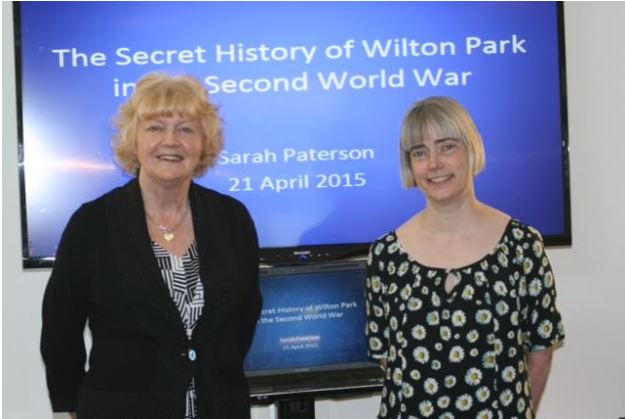On 21st April 2015, Sarah Paterson, Senior Librarian at the Imperial War Museum, gave a fascinating talk to a sell-out audience in Beaconsfield on the secret history of Wilton Park in World War 2. Much detailed information was revealed about what had been a top -secret intelligence centre in WW2. Kari Dorme who organized the event and introduced the speaker said, “It was a wonderful and informative evening learning about the clandestine work of the secret listeners at Wilton Park. Sarah told us that the lovely grounds relaxed the Nazi PoWs, but that not only their cells but even the trees were bugged! What impressed me most was the eagerness with which so many of the audience shared their own knowledge and asked questions over a wide range of issues. At the end the place was really buzzing with the interest of it.”
Mike Elliott the Chairman of the Beaconsfield Society said, “Clearly Wilton Park is of great interest to local residents. Those lucky enough to get the hottest tickets in Beaconsfield were rewarded with an excellent talk plus enthusiastic and informative contributions from the floor. I hope we can devise a fitting way to recognize the importance of the site to the town.”
WW2 changed Wilton Park’s history forever. Leased to the War Office in 1939, it became a top-secret interrogation centre for Nazi prisoners of war and the most important POW site in the country. The activities that took place there were hidden at the time and are still little known today.
Secret interrogation and re-education. Wilton Park was the biggest POW site in the country.
During the war, enemy prisoners of war were interrogated at Wilton Park before being sent on to their permanent camps. By bugging their cells, the British obtained valuable information from their monitored conversations. They also gathered intelligence from British POWs in Axis hands and sent help to enable them to escape. Sarah described how specially made boots with hidden compartments for survival kits were issued to resistance workers at Wilton Park. Also to help them escape in Europe they were given secret maps printed onto silk or rayon, this was really pre-James Bond stuff!
After the war, the site was used as a re-education centre for German POWs. The Foreign Office ran ‘de-nazification’ programmes to encourage independent thought and promote a democratic way of life, with the aim of re-establishing democracy in Germany.
In 1951, the Beaconsfield site was occupied by the Army Education Corps which later became the Defence School of Languages and the courses for democracy were moved to Wiston House, near Steyning in Sussex, where they retain the Wilton Park name.
Preserving the Wilton Park story
The house itself was demolished in 1968 and the Army left in 2014. The 100-acre site was sold by the Ministry of Defence to developers Inland Homes, who have submitted plans to build 350 new houses there. The Beaconsfield Society believes it is important to raise awareness of Wilton Park’s secret history and find ways of commemorating it, before this part of our town’s heritage is lost to view. The Society received a boost days after the talk when Inland Homes announced that they had saved the beautiful mosaic which had been in the officer’s mess at Wilton Park. The Society hopes that one day this will be available to be displayed to the public.
Kari Dorme (Committee member and event organiser)

